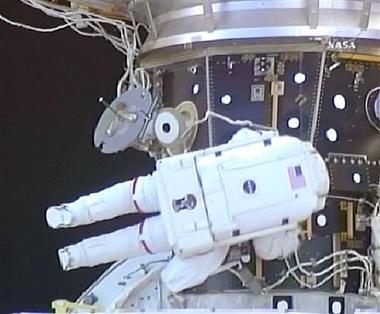NASA studies gouge on Endeavour's belly
Updated: 2007-08-14 17:28
HOUSTON -- If astronauts have to venture into the void of space to fix a deep gash on the shuttle Endeavour's belly, they'll get plenty of help from a team of experts assembled to help pick and perfect the best repair technique.
 In this image from NASA television, space shuttle Endeavour astronaut Rick Mastracchio adjusts tethers near the docking interface on the international space station during a space walk Monday, Aug. 13, 2007. [AP] |
NASA put together the team of engineers, astronauts and spacewalk gurus on Monday as other specialists scrambled to determine whether the crew needed to fix the gouge to avoid extensive post-flight repairs. A decision was expected by Wednesday.
The gouge is relatively small - 3 1/2 inches by 2 inches - and the damage is benign enough for Endeavour to fly safely home. But part of it penetrates through the protective thermal tiles, leaving just a thin layer of coated felt over the space shuttle's aluminum frame to keep out the more than 2,000-degree heat of re-entry. Fixing any resulting structural damage could be expensive and time-consuming.
To patch the gouge, spacewalking astronauts would have to perch on the end of the shuttle's 100-foot robotic arm and extension boom, be maneuvered under the spacecraft, and either apply protective black paint or squirt in a caulk-like goop.
Mission Control told the crew late Monday that officials had ruled out a third repair technique involving a protective plate that could be screwed over the damage.
All three techniques were developed following Columbia's catastrophic re-entry, and NASA has never attempted this type of repair on an orbiting shuttle. Only the black paint has been tested in space.
Astronauts Rick Mastracchio and Dave Williams have trained extensively on the ground and could perform any necessary repairs during the mission's fourth spacewalk set for Friday. Their last tile-repair class was just three or four weeks before launch.
"I think that regardless of what repair method is chosen over the next day or so, we could execute it if required," said John Shannon, chairman of the mission management team.
Covering the exposed white coated felt with black protective paint would keep heat from building up in the cavity, Shannon said.
For extra heat protection, the astronauts could also squirt in the caulk-like goop from a tank attached to their spacesuit's backpack. In that case, they would apply the paint first to make sure the goop stuck.
If the repairs are ordered, astronauts on the ground will practice repairing a replica of the gouge underwater so they can create precise instructions for the spacewalkers and their crewmates.
When an astronaut from the shuttle Atlantis' June mission had to staple up a thermal blanket that had peeled back during launch, the ground crew sent him 60 pages of instructions and four videos, Shannon said.
Mastracchio and Williams have already completed two spacewalks in three days. On Monday, they removed a 600-plus-pound gyroscope from the space station's exterior that failed last October. They installed a new one in its place that was carried up aboard Endeavour. The space station has four gyroscopes to keep it steady and pointed in the right direction.
Teacher-astronaut Barbara Morgan - Christa McAuliffe's backup for Challenger's doomed mission in 1986 - helped monitor the spacewalk from inside the joined shuttle-station complex.
On Tuesday, Morgan will speak with students in Idaho, where she taught elementary classes before moving to Houston in 1998 to become the first teacher to train as a full-fledged astronaut.
A list of topics Mission Control sent her on Monday included questions from children about what it's like to be weightless, how the crew gets clean air aboard the shuttle, and what stars look like from space.
Morgan and her crewmates will spend the rest of Tuesday using Endeavour's robotic arm to help install a new storage platform on the space station. After pulling the platform from the ship's cargo bay, they will pass it off to the station's robotic arm for installation.
|
|
|
||
|
||
|
|
|
|